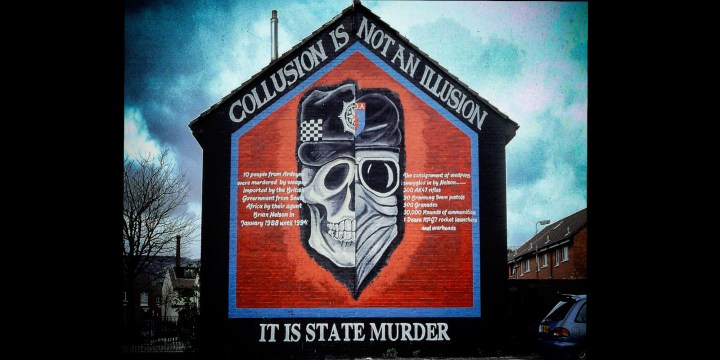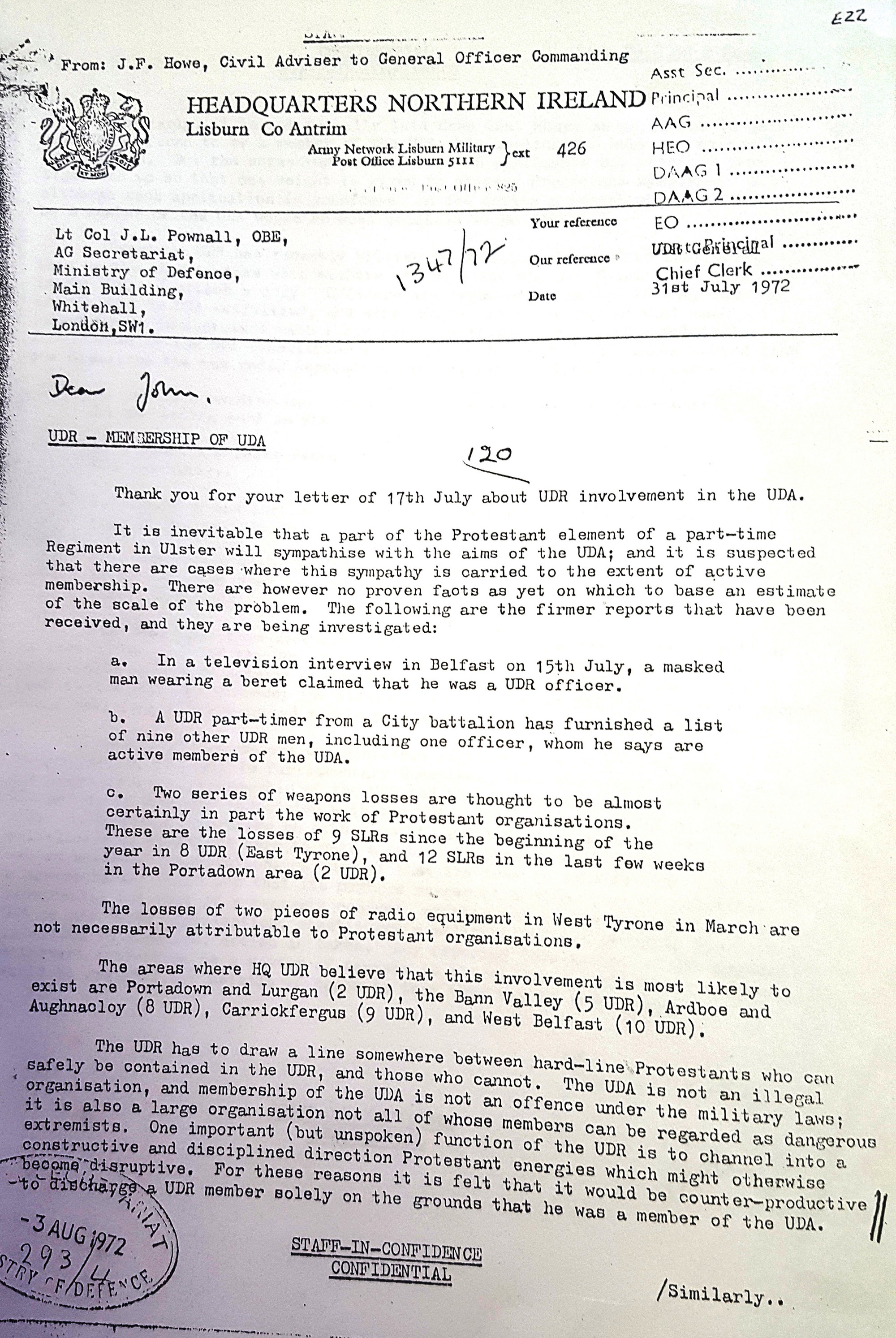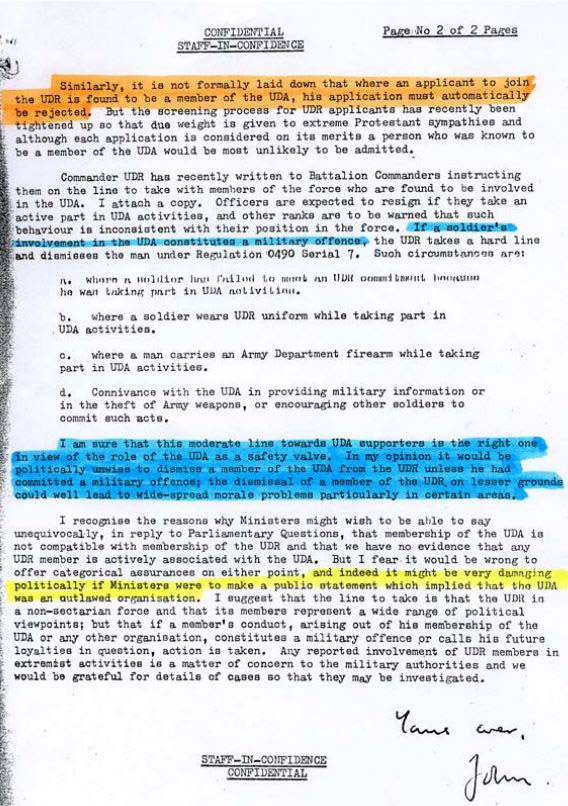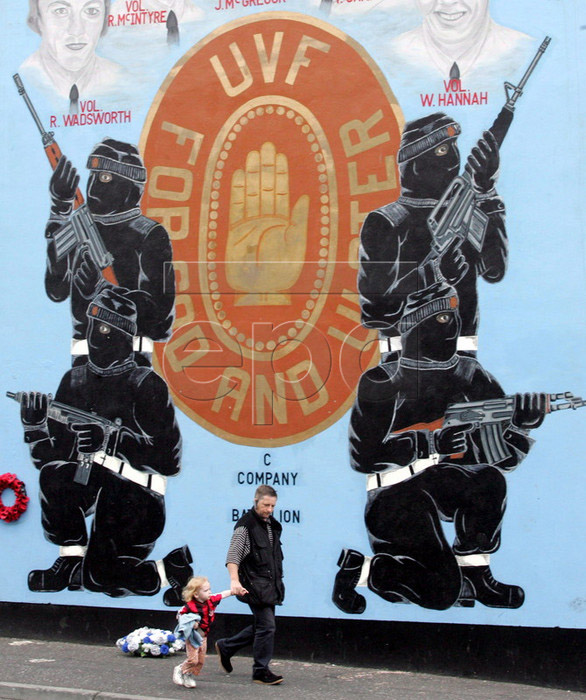Declassified UK
Explainer: British collusion in Northern Ireland’s dirty war

An emerging body of evidence shows that during the decades-long conflict in Northern Ireland, a number of British military, police and security agencies were engaged in a ‘dirty war’ where human rights and the law were jettisoned in covert counter-insurgency strategies.
Various sources — including declassified government files and official police and parliamentary reports on both sides of the border in Ireland — suggest that collusion between British security forces and loyalist paramilitary groups was systematic and resulted in the deaths of hundreds of people.
The so-called “Troubles” in Northern Ireland began in the late 1960s. Republican (or nationalist) paramilitary groups — principally the Provisional Irish Republican Army (IRA) — fought a violent campaign to unite the territory with the 26 counties in Ireland.
On the other side were unionist (or loyalist) paramilitary forces, established to protect the union with Britain, by force of arms if necessary. These were mainly the Ulster Volunteer Force (UVF) and the newer and larger Ulster Defence Association (UDA).
‘Dozens and dozens’ of murders
Lord Stevens, a former senior British police officer who led three government investigations into the security forces in Northern Ireland, has stated that the British recruited thousands of agents and informants during the Troubles, and that just one of them may be linked to “dozens and dozens” of murders. During his investigations, Stevens and his team arrested 210 paramilitary suspects, of whom, he said, 207 were agents or informants for the British state.
The lawyer Pat Finucane was shot dead in front of his wife and children in Belfast in 1989 by a UDA hit squad which included British police and military agents. The most recent government-ordered review of the murder noted that 85% of the UDA’s intelligence originated in one arm or other of the British security agencies. It also stated that the UDA was “heavily reliant on the flow of [British] security force leads to enable them to identify republican targets” and that “many UDA attacks could be traced back to assistance initially provided by one of their [British] security force contacts”.
Research by Mark McGovern, a professor at Edge Hill University in England, has focused on the activities of loyalist murder squads in areas of Northern Ireland in the late 1980s and early 1990s. It found that weapons smuggled into Northern Ireland from apartheid South Africa — with the help of British intelligence — were used to kill dozens of Catholics between 1988 and 1994.
The British government has always claimed it was not involved in paramilitary activities and that its role in Northern Ireland was limited to defeating the IRA, upholding the rule of law and preserving the union. As the conflict raged in the early 1970s, claims of collusion between loyalist paramilitary gangs and the British state were widely dismissed as republican propaganda. However, a growing body of work by journalists and historians now makes this position unsustainable.
Researchers, including those in my own organisation, the Pat Finucane Centre, have discovered dozens of declassified official files where the term “collusion” — describing the relationship between loyalist paramilitaries and the British state — is routinely used in internal reports dating back to the earliest days of the conflict.
The UK’s Ulster Defence Regiment and loyalist paramilitaries
Established in 1970, the Ulster Defence Regiment (UDR) became the largest regiment in the British army consisting of about 7,000 full-time and part-time soldiers in the 1970s. Recruited from the local population in Northern Ireland, it was one of the UK’s main forces focused on defeating the IRA.
Files from the early 1970s show that neatly prepared monthly records were kept of the routine disappearance of weapons from UDR arsenals, each one clearly stating that “collusion” was suspected; that is, these British military weapons were going to loyalist paramilitaries.
One UK Ministry of Defence letter — written to the British under-secretary of state for the army in August 1972 — made open reference to “collusion” in the loss of these weapons. Yet the Royal Ulster Constabulary (RUC), Northern Ireland’s police force, rarely investigated the disappearance of these arms and they were never admitted in public.

A letter dated 7 August 1972, from the Ministry of Defence to the under-secretary of state for the army, mentioning collusion in the loss of weapons. (Source: National Archives, DEFE 24/822 – UDR 1972 image 31, https://discovery.nationalarchives.gov.uk/details/r/C10960981)
By mid-1972, when the UDR was still being fully formed, the Ministry of Defence was aware that some members of the UDR were also active members of the UDA paramilitary group. It noted that it was “inevitable that a part of the Protestant element of a part-time regiment in Ulster will sympathise with the aims of the UDA”.

A British army memo of July 1972 notes that it was ‘inevitable that a part of the Protestant element of a part-time regiment in Ulster will sympathise with the aims of the UDA’. (Source: National Archives, https://www.patfinucanecentre.org/sites/default/files/2016-11/1972_02.pdf)
Senior British officers were also aware that active members of loyalist paramilitary gangs would join the army’s UDR to gain intelligence, training and access to weapons to better pursue their illegal paramilitary activities in parallel with their official supposed peace-keeping duties.
A ‘moderate line’ towards paramilitaries
As the conflict wore on, the British authorities were increasingly tolerant of soldiers in the UDR also being members of loyalist paramilitary groups. An MOD document in 1972 noted that the British should follow a “moderate line towards UDA supporters”. This was described as providing a “safety valve” for extreme Protestant tendencies. It suggested that taking a harder line by dismissing members of the UDR for membership of the paramilitary UDA would lead to “widespread morale problems”.

A Ministry of Defence document from 1972 noted that a ‘moderate line towards UDA supporters’ should be followed. (Source: National Archives, https://www.patfinucanecentre.org/sites/default/files/2016-11/1972_03.pdf)
By August 1973, the British army admitted in an internal assessment that between 5-15% of UDR members were active in paramilitary groups, although the actual figure is likely to have been far higher.
The same assessment noted that the UDR was also “the best single source of weapons (and the only significant source of modern weapons) for Protestant extremist groups”, and that “an element of collusion was present” in the theft of weapons. It also noted reports of UDR soldiers giving “weapons training” to extremist loyalist groups, including the UDA.
Moreover, the document also stated that “a number” of British UDR soldiers holding positions in the paramilitary UDA and other groups “have been involved in overt terrorist acts”.
Despite this knowledge on the part of the British army, there is no evidence it made serious efforts either to root out those responsible or end such actions.
In fact, other files show that by the late 1970s, British UDR units were financing and supporting another paramilitary group, the Ulster Volunteer Force (UVF) in Belfast, with at least 70 soldiers on one UDR base linked to the group.
British army chiefs have been exposed as covering up evidence of this collusion, which also involved a UDR soldier being involved in the UVF’s notorious Shankill Butchers gang. This group was effectively a death squad, undertaking a sectarian murder campaign in Belfast which abducted, tortured and killed at least 10 Catholics.
Another British declassified document from 1975 reveals concerns from senior British army officers — which were communicated to then prime minister Harold Wilson — that the UDR was “heavily infiltrated” by loyalist paramilitaries and could not be relied upon to follow orders. The response from the British government was not to disband the UDR but to mobilise it along the border between Northern Ireland and Ireland, and increase its numbers and its intelligence-gathering role.
The legal paramilitary group
Throughout the conflict, the consistent argument from the Irish government in Dublin and the moderate nationalist Social Democratic and Labour Party in Northern Ireland was that the paramilitary UDA should be proscribed. Yet, as its activity continued throughout the 1970s and 1980s, the UDA was permitted to recruit and operate openly and remained a legal organisation until 1992.
Writing to the British government in July 1972, even General Sir Harry Tuzo, the senior British military officer in Northern Ireland, warned that the paramilitary UDA’s “militant action will lead to widespread inter-sectarian conflict and eventually civil war”. With a force of 25,000, the UDA would continue to try to influence the political and military situation and provoke trouble by “indiscriminate shooting into Catholic areas”, General Tuzo wrote.
Even though this would increase support for the IRA, Tuzo accepted that the British army should “acquiesce in unarmed UDA patrolling and barricading of Protestant areas”. Indeed, the UDA was often allowed to patrol its “own areas” in uniform, sometimes wearing masks. The authorities even went so far as to turn a blind eye to the UDA patrolling with arms and sometimes even allowed it to patrol with British troops.
The British government regularly claimed that loyalist killings were carried out in the name of the Ulster Freedom Fighters (UFF) and not the UDA which, it said, was a separate organisation.
An internal 1976 British assessment, however, told a different story.
It stated that, “the UDA is the largest and best-organised of the loyalist paramilitary organisations”, which “tries to maintain a respectable front” either by denying responsibility for sectarian murders or claiming them “in the name of the Ulster Freedom Fighters, a proscribed and essentially fictitious organisation which is widely known to be a nom de guerre for the UDA”.

A 1976 internal British assessment noted that, ‘The UDA is the largest and best-organised of the loyalist paramilitary organisations’ and that the Ulster Freedom Fighters were ‘a proscribed and essentially fictitious organisation which is widely known to be a nom de guerre for the UDA’. (Source: National Archives, https://www.patfinucanecentre.org/declassified-documents/declassified-document-uff-fictitious-020976)
The police and the UVF
There is also evidence of systemic collusion between the Northern Irish police and the two main paramilitary organisations, the UVF and the UDA.
British documents from 1975 noted that there were “certain elements in the police” who were very close to the UVF. One former sergeant in the police wrote in a 1999 affidavit that “collusion” was endemic.
A particularly egregious example is that of Robin Jackson, an agent of the police and former soldier in the British army’s UDR, who is believed to have been behind more than 50 murders between 1973 and 1998 when he died. These included the deaths of three musicians in what has become known as the Miami Showband Massacre in 1975.
Another case is that of Gary Haggarty, a UVF leader in north Belfast who was a paid informer for the police for 11 years. Haggarty admitted to five murders and a further five attempted murders, alongside hundreds of other offences such as kidnappings and arson attacks, committed in the 1990s and early 2000s.
The Historical Enquiries Team, which was set up by the government in 2005 to investigate unresolved murders, found repeated and inexplicable police failures to investigate many murders. The guns used in one attack in June 1976, for example, where all the perpetrators were serving police officers, were also used to kill 16 other people in at least seven other attacks. The police failed to investigate the links.
Further evidence of collusion is still emerging. Two former police ombudsmen for Northern Ireland have found substantial collusion between the police and the UVF. The first case involves a three-year investigation into more than a dozen murders in north Belfast in the 1990s. The second concentrates on the murders of six men in a bar in the village of Loughinisland in County Down in 1994.

A file photograph showing a man and his child walk past an Ulster Volunteer Force (UVF) mural on the Shankill road, west Belfast, Northern Ireland, 14 September 2005. (Photo: EPA/Paul Mcerlane)
For more than three years, the police ombudsman has been conducting its largest-ever inquiry, investigating collusion involving British state forces in the “Glenanne Gang” – a group of loyalists, UDR and police officers — who carried out numerous bomb attacks and shootings in the 1970s. Four years of legal action have recently concluded with a Belfast high court ruling that the victims’ families have a “legitimate expectation” of a comprehensive report into collusion in more than 120 murders involving the Glenanne Gang.
All of this perhaps explains why some files in the National Archives relating to Northern Ireland — often already examined and published by researchers — are being re-closed, further exacerbating fears that the state will not allow the truth to emerge.
Patterns of collusion
The Pat Finucane Centre and others have deduced from our research that the targets of collusion changed over the decades from being civilians not involved in the conflict in the 1970s to active republicans and their families in the 1980s and 1990s. Evidence for this comes in three recently published books: Lethal Allies: British Collusion in Ireland, Counterinsurgency and Collusion in Northern Ireland, and A State in Denial.
Three recent film documentaries also focus on collusion, often drawing on information from official archives: Unquiet Graves: The Story of the Glenanne Gang; The story of the Miami Showband Massacre; and No Stone Unturned, covering the Loughinisland murders. These follow other broadcast documentaries, such as the RTE (Irish television) film in 2015 which highlighted several instances of alleged collusion involving the British army, MI5 and the RUC, from the 1970s to the early 2000s, including the shocking Dublin-Monaghan bombings, which claimed 34 lives.
Both sides in the conflict remain engaged in a bitter battle over the real history of collusion. Many unionists continue to assert that collusion was an insignificant factor in the conflict, a case of a “few bad apples”, while nationalists assert that collusion was state policy. The latter claim has been strongly rejected by successive British governments.
Following the publication of a report into the Pat Finucane murder in 2012, the then British prime minister, David Cameron, made an explicit admission in the House of Commons that the depth of the co-operation between the security forces and Finucane’s loyalist killers was “unacceptable”.
Cameron denied, however, that there was any overarching policy to use loyalists to target members of the nationalist community or active republicans.
If state forces continue to be exposed for being at least partly responsible for the deaths of hundreds more people than previously stated, the official narrative that the British government acted as a benevolent umpire in the conflict in Northern Ireland will continue to weaken. The British government will instead stand accused of manipulating paramilitary forces to help defeat its enemies in a colonial dispute.
The stakes are high and mean the historical battle over the depth and significance of collusion will continue in the coming years. The British state appears determined to keep its secrets hidden, but a growing group of researchers remains determined to reveal exactly what happened during the Troubles. DM
Anne Cadwallader, a former BBC journalist, is an author and advocacy caseworker at the Pat Finucane Centre in Armagh, Northern Ireland.
Declassified UK is an investigative journalism organisation analysing Britain’s foreign, military and intelligence policies. @DeclassifiedUK














 Become an Insider
Become an Insider